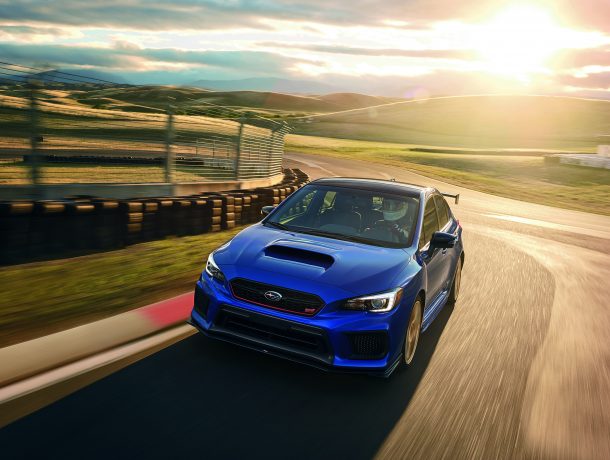Winging It: Subaru Reveals Limited Edition 2018 WRX STI Type RA and BRZ TS

It’s a lot of letters, but not a lot of extra horsepower. That’s the synopsis of two limited edition performance models revealed by Subaru today.
We already knew both were on the way, and indeed the models seem well equipped to trounce the handling dynamics of their regular-production stablemates. The appearance, too. Festooned with every measure available to enhance downforce, braking, body stability, and traction, the 2018 WRX STI Type RA (“Record Attempt”) and BRZ tS are instant collector’s items for Subaru superfans.
Is there more power to be had? Are both the revamped WRX and BRZ faster than their corporate siblings? Short answer: yes, and…maybe?
You’ll know the WRX STI Type RA to see it, both inside and out. Besides the special console-mounted plaque telling the lucky driver (nestled in a Recaro performance seat) exactly which vehicle of just 500 planned units they’re piloting, the Type RA makes its presence known with a bevy of go-fast add-ons.
For starters, there’s a carbon fiber pedestal wing rising majestically to the sky, complimented by a carbon fiber roof panel and an additional gray downforce enhancement up front. To reduce heft further, the Type RA dons lightweight BBS 19-inch forged alloy wheels wrapped in 245/35R19 Yokohama Advan Sports rubber. Don’t even thing of looking for a spare tire in that trunk.
The Type RA’s legs have also been to the gym. Underneath, inverted front struts and rear double wishbone suspension all share Bilstein dampers, with Brembo six-piston front calipers and dual-piston rear calipers squeezing cross-drilled discs. Subaru has modified the vehicle’s Vehicle Dynamics Control (VDC) system to improve stability.
Power? There’s a touch more power, along with improved acceleration. However, exact specifications, along with pricing, will have to wait. The automaker has massaged its turbocharged 2.5-liter Boxer four-cylinder up to an estimated 310 horsepower — a gain of 5 ponies, all thanks to a retuned engine control unit, STI-specified cold air intake and high-flow exhaust system. A revised third gear ratio on the six-speed manual transmission collaborates with the engine modifications and unspecified weight loss to boost acceleration.
These powertrain improvements won’t be found in the Type RA’s rear-drive cousin, however. For the BRZ tS, handling is the word of the day. You’ll find a sky-high, manually adjustable carbon fiber spoiler out back, which is perfect for owners who like to obsess over minutiae. Further STI-crafted airflow enhancers line the bottom edges of the vehicle. Lightweight STI 18-inch wheels adorn the corners, harnessed by Brembo brakes.
Beneath the BRZ tS, Subaru added STI-tuned front and rear SACHS dampers and coil springs to aid the vehicle’s handling, tossing flexible V-braces in the engine compartment for good measure. To improve the vehicle’s steering response, engineers added new draw fasteners to the chassis and sub-frame.
Of course, this isn’t the full list of changes you can expect to find, but a person can only take so much. Will the two groups of 500 vehicles even make use of the fine tuning? That’s up to the buyers. Both vehicles will become available at Subaru dealers in early 2018, with the automaker disclosing specs and dollar figures later this year.
[Images: Subaru of America]

More by Steph Willems
Latest Car Reviews
Read moreLatest Product Reviews
Read moreRecent Comments
- SCE to AUX Range only matters if you need more of it - just like towing capacity in trucks.I have a short-range EV and still manage to put 1000 miles/month on it, because the car is perfectly suited to my use case.There is no such thing as one-size-fits all with vehicles.
- Doug brockman There will be many many people living in apartments without dedicated charging facilities in future who will need personal vehicles to get to work and school and for whom mass transit will be an annoying inconvenience
- Jeff Self driving cars are not ready for prime time.
- Lichtronamo Watch as the non-us based automakers shift more production to Mexico in the future.
- 28-Cars-Later " Electrek recently dug around in Tesla’s online parts catalog and found that the windshield costs a whopping $1,900 to replace.To be fair, that’s around what a Mercedes S-Class or Rivian windshield costs, but the Tesla’s glass is unique because of its shape. It’s also worth noting that most insurance plans have glass replacement options that can make the repair a low- or zero-cost issue. "Now I understand why my insurance is so high despite no claims for years and about 7,500 annual miles between three cars.





































Comments
Join the conversation
Unless the cost of this edition is not much more (say, $1.5-2k), this is a big fat middle finger from SOA to loyal Subaru fans (like myself) who were hoping for something, ANYTHING new for the STI. There's barely anything here that makes a difference and can't be done aftermarket. I'm sure there are better suspension upgrades available, although it's not a BAD thing. IIRC, the 6-piston brakes are the same as the regular STI. I mean, 5 hp is just about the lowest possible increase in HP that you can still call an increase - I mean if it was 307, you'd almost be laughed at for mentioning it. About the only thing possibly useful here is stronger pistons - if those are helpful in addressing the ringland problem, THAT would be something..
But guys, that wing will add at least 2, maybe even three inches to your d!ck! I don't understand the science behind it but it's totally true.